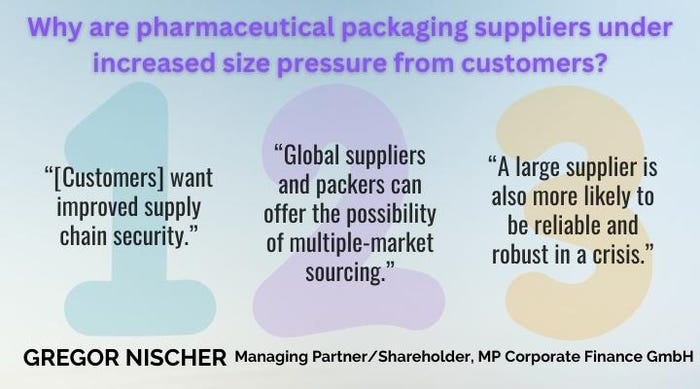Mergers and acquisitions among pharmaceutical packaging suppliers give drug manufacturers at least three big benefits, says a financial expert who is speaking at Pharmapack Europe 2023.
January 30, 2023

Content Team at Pharmapack
Increasingly, to minimize their supply risk, many pharmaceutical companies opt to work only with larger packaging suppliers. The effects of this are likely to shape the market over the next few years. In particular, how a majority of smaller and medium-size pharmaceutical packaging companies are going to need to grow — or be particularly exposed to potential acquisitions.
This is one of the trends on the agenda for Pharmapack Europe 2023 (February 1-2; Paris, France). Ahead of the event, Packaging Digest caught up with Gregor Nischer, Managing Partner & Shareholder at MP Corporate Finance GmbH, to get his insights into what the year ahead holds for the packaging market in terms of consolidations and partnering.
In his session on the opening day, February 1 — where more than 5,000 attendees and 300 exhibitors are expected — Nischer will look into why size matters and what is behind the key drivers for consolidation in pharmaceutical packaging.
Does size matter for packaging companies serving the pharmaceutical sector?
Nischer: In the last few years, size requirements have become an increasingly key driver for consolidation. This is in part a reflection of regulatory changes and the growth of pharma companies that are looking for improved supply chain security.
Pharma customers like to have suppliers they can reply upon for more than single components (such as caps, bottles, and labels). Increasingly, they want providers that can provide complete solutions.
At the same time, regulations are becoming more complex, and small companies don’t have the necessary resources — meaning the development of products is becoming prohibitively expensive.
The other significant aspect is that many companies are looking to sell products globally. In this regard, smaller suppliers are further challenged with having the significant divergence of multiple regulatory burdens — and this can become unmanageable. In fact, a notable trend had been the recent spate of acquisitions of larger USA manufacturers buying European-based manufacturers to gain a foothold here.
I think this is driven by three reasons:
First, the customer base is getting bigger and bigger. And with the bigger customer base, they have higher requirements, meaning the ongoing consolidation in the pharma field also drives requirements for packaging suppliers.
Second, the regulatory environment gets tougher every year.
And third, the packaging industry is a rather old industry, if you look into plastics packaging. And a consultation trend has to develop in the end to keep fit.
What are the benefits/disadvantages of a fragmentated sector? Does it have any effect on innovation?
Nischer: I doubt it has impact on innovation because innovation is capital intensive, and you have to be a certain size to be innovative. What less fragmentation might do, as economies of scale take hold, is make the supplier less and less flexible to individual pharma requirements. It is much more difficult to do when you have higher throughput and more customers, so product standardization rather than individualization is likely. A smaller company is more likely to want to do “anything” to keep the contract and make those unique specification adjustments.

Why are customers putting pharmaceutical packaging suppliers under increased size pressures?
Nischer: The single biggest reason is that they want improved supply chain security. And global suppliers and packers can offer the possibility of multiple-market sourcing. A large supplier is also more likely to be reliable and robust in a crisis.
Could strategic alliances be the solution to these trends?
Nischer: A cooperation you do see sometimes is for a couple of smaller providers, such as a closure manufacturer intensively cooperating with a glass or bottle producer. Together, they want to be able to sell a solution to the pharma customer.
However, it’s more preferable for these smaller companies to “acquire in” the assets or “buy in” the products so that they can be the sole seller and responsible company to their pharma customer. Working in a collaboration, despite offering essentially the same end product, is far less attractive for the pharma customer as it introduces a less clear route of responsibilities – that is, in the event of complexity, who is to blame.
So, what does all this mean for the immediate future in the year ahead? Pharma is a slower-moving industry, so we won’t see dramatic shifts. Rather, we’re likely to see a methodical and steady change as we see fewer smaller and nimble companies and more medium-sized groups built through acquisition.
In terms of ownership, the trend thus far is for US buying European — and this is mostly a reflection of there being more larger companies in the USA. So if we look at the European market solely through the prism of turnover, I think we could say those companies with a turnover of €80 million or above, I would think are broadly safe. Those with less than €20million are highly vulnerable, and those between €20 and €70 million should be looking at their options in terms of how they can acquire and build towards the €100 goal.
These are, of course, also potentially the most attractive assets for investors. And I think this is where you will see the biggest movement in the year ahead. How can these companies be delivered the capital to grow out and acquire complementary assets — potentially in other continents?
I would therefore also imagine that Pharmapack Europe itself is potentially a very big shop window for many of these US investors and companies looking for entry into Europe.
EDITOR’S NOTE: Pharmapack Europe is owned and produced by Informa, the parent company of Packaging Digest.
You May Also Like


